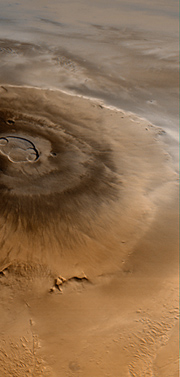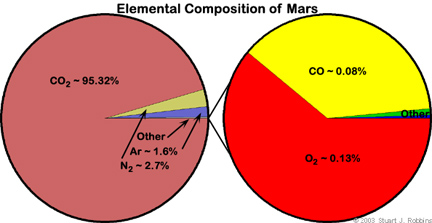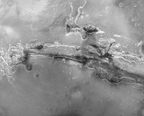Mars
Mars' Moons | "Life" on
Mars

Mars is about half the size of our planet, Earth.
It's thin atmosphere is slowly being blown away by the sun's solar
wind. However, its atmosphere forms clouds, and sometimes supports planet-wide
dust storms.
The red planet has many features that are visible to the backyard
observer with a powerful enough telescope. First of all, Mars has a reddish color
due to the iron oxide - commonly known as rust - that is in the soil.
The first feature that most can see on Mars are the polar ice
caps. These huge caps of water and carbon dioxide ice expand and shrink due to
seasonal changes on Mars.
 Second, "canals" and "seas" cover
the entire planet. The canals may have been waterways many millions or billions
of years ago, but they are now dry, as are the seas. The seas were probably oceans
that covered parts of Mars. Second, "canals" and "seas" cover
the entire planet. The canals may have been waterways many millions or billions
of years ago, but they are now dry, as are the seas. The seas were probably oceans
that covered parts of Mars.
Third, the largest volcano in our solar system, Olympus Mons,
lies on Mars. It is 24 km (15 miles) high, and the top of it is 70 km (40 miles)
wide; the base is about 600 km (375 miles) wide. This volcano is now dormant,
but was active millions of years ago.
Mars is also home to one of the longest (more than 4,000 km
(2500 miles long)) canyon systems in the solar system called Valles Marineris
("Mariner Valley"). The canyon system ranges from 5 to 8 km (3-5 miles)
deep. If placed on Earth, this would stretch from New York to Los Angeles.
You can find the current weather of Mars, as well as its position
relative to Earth at the Mars
Today home page, sponsored by NASA.
 As
can be seen in the table below, Mars' atmosphere is much less than Earth's and
Venus', and it exerts a pressure of only 0.000636 bars at the surface. Its composition
is nearly all CO2; the rest is approximately: As
can be seen in the table below, Mars' atmosphere is much less than Earth's and
Venus', and it exerts a pressure of only 0.000636 bars at the surface. Its composition
is nearly all CO2; the rest is approximately:
- CO2: 95.32%
- N2: 2.7%
- Ar: 1.6%
- O2: 0.13%
- CO: 0.08%
- H2O: 0.021%
- NO: 0.01%
- Ne: 0.00025%
- HDO: 0.000085%
- Kr: 0.00003%
- Xe: 0.000008%
The surface density is 20 g/m3. Below 30° latitude,
wind speeds range up to 150 m/s, and above that only 40 m/s. The scale height
of the Jovian atmosphere is about 11.1 km.
It is not yet clear how Mars' atmosphere evolved. It is assumed
that its original composition was as the other planets - mostly hydrogen and
helium. It probably evolved in a slightly similar fashion to Venus and Earth.
 Mars
is the most Earth-like planet in the solar system (except for in size and therefore
surface gravity; Venus takes the cake for that characteristic).
Because of this, several scientists believe that, if done correctly, Mars can
be terra formed into a planet inhabitable by humans. Mars
is the most Earth-like planet in the solar system (except for in size and therefore
surface gravity; Venus takes the cake for that characteristic).
Because of this, several scientists believe that, if done correctly, Mars can
be terra formed into a planet inhabitable by humans.
Mars has some unique characteristics:
- First off, Mars has the largest volcano in the solar system, Olympus Mons.
- It also has the largest canyon system in the solar system called Valles Marineris.
This is pictured to the right.
- Third, Mars is the only other planet besides Earth to posses frozen water
at its poles, which scientists have seen grow and shrink as the Mars seasons
change.
- Fourth, Mars is the only other planet (that we know of) that has the capability
of supporting life, past or present (see "Life" on
Mars).
- Marsnik 1 (Mars 1960A) - attempted Mars flyby (launch failure) in 1960
- Marsnik 2 (Mars 1960B) - attempted Mars flyby (launch failure) in 1960
- Sputnik 22 - attempted Mars flyby in 1962
- Mars 1 - Mars flyby (contact lost) in 1962
- Sputnik 24 - attempted Mars lander in 1962
- Mariner 3 - attempted Mars flyby in 1964
- Mariner 4 - 1 flyby in 1964
- Zond 2 - Mars flyby (contact lost) in 1964
- Mariner 6 - 1 flyby in 1969
- Mariner 7 - 1 flyby in 1969
- Mars 1969A - attempted Mars orbiter (launch failure) in 1969
- Mars 1969B - attempted Mars orbiter (launch failure) in 1969
- Mariner 8 - attempted Mars flyby (launch failure) in 1971
- Cosmos 419 - attempted
Mars orbiter and lander in 1971
- Mars 2 - Mars orbiter and attempted lander in 1971
- Mars 3 - Mars orbiter and lander in 1971
- Mariner 9 - 1 flyby in 1971
- Mars 4 - Mars flyby and attempted Mars orbiter in 1973
- Mars 5 - Mars orbiter in 1973
- Mars 6 - Mars lander (contact lost) in 1973
- Mars 7 - Mars flyby and attempted Mars lander) in 1973
- Viking 1 - Mars orbiter and lander in
1976
- Viking 2 - Mars orbiter and lander in
1976
- Phobos 1 - attempted Mars orbiter and Phobos landers in 1988
- Phobos 2 - Mars orbiter and attempted Phobos landers in 1988
- Mars Observer - attempted Mars orbiter (contact lost) in 1992
- Mars Global Surveyor - Mars orbiter from 1996-Present
- Mars 96 - attempted Mars orbiters/landers
- Mars Pathfinder - Mars lander
in 1997
- Nazomi (Planet-B) - ISAS Mars orbiter in 1998
- Mars Climate Orbiter - attempted Mars orbiter in 1998
- Mars Polar Lander - attempted Mars lander in 1999
- Deep Space 2 (DS2) - attempted Mars penetrators in 1999
- 2001 Mars Odyssey - Mars orbiter from 2001-Present
- Mars Express - Mars orbiter from 2003-Present and attempted lander
- Spirit (MERA) - Mars lander from 2004-Present
- Opportunity (MERB) - Mars lander from 2004-Present
- Mars Reconnaisance Orbiter - Mars orbiter with a planned launch in 2005
- Phoenix - Mars scout lander with a planned launch in 2007
- Netlanders - Mars netlanders with a planned launch in 2007
- Mars 2009 - Mars science laboratory rover with a planned launch in 2009
- Mars 2011 - Mars scout mission with a planned launch in 2011
Mars obtained its name due to its deep, war-like red color.
The Romans named the planet after their god of war, Mars. Olympus Mons, the largest
volcano in the solar system is named after Mount Olympus, the home of the Greek
/ Roman gods and goddesses. Mars' two moons, Phobos
and Deimos, are named after Fear and Panic, the two lackeys of Mars.
|
| Perihelion (106 km) |
46.00 |
107.5 |
147.09 |
206.62 |
740.52 |
1352.55 |
2741.30 |
4444.45 |
| Mean Orbital Distance (106 km) |
57.91 |
108.2 |
149.60 |
227.92 |
778.57 |
1433.53 |
2872.46 |
4495.06 |
| Aphelion (106 km) |
69.82 |
108.9 |
152.10 |
249.23 |
816.62 |
1514.50 |
3003.62 |
4545.67 |
| Average Orbital Velocity (km/s) |
47.87 |
35 |
29.78 |
24.13 |
13.07 |
9.69 |
6.81 |
5.43 |
| Orbital Inclination (from
Earth's Orbit) |
7.00° |
3.4° |
0.0° |
1.850° |
1.304° |
2.485° |
0.772° |
1.769° |
| Orbital Eccentricity |
0.2056 |
0.007 |
0.0167 |
0.0935 |
0.0489 |
0.0565 |
0.0457 |
0.0113 |
| Equatorial Radius (km) |
2439.7 |
6051.8 |
6378.1 |
3397 |
71,492 |
60,268 |
25,559 |
24,764 |
| Polar Radius (km) |
2439.7 |
6051.8 |
6,356.8 |
3375 |
66,854 |
54,364 |
24,973 |
24,341 |
| Volume (1010 km3) |
6.083 |
92.843 |
108.321 |
16.318 |
143,128 |
82,713 |
6833 |
6254 |
| Ellipticity (Variation from
Sphere) |
0.0000 |
0.000 |
0.00335 |
0.00648 |
0.06487 |
0.09796 |
0.02293 |
0.01708 |
| Axial Tilt (from Earth's geographic
North) |
0.01° |
177.4° |
23.45° |
25.19° |
3.13° |
26.73° |
97.77° |
28.32° |
| Mass (1024 kg) |
0.3302 |
4.87 |
5.9736 |
0.64185 |
1898.6 |
568.46 |
86.832 |
102.43 |
| Density (water=1) |
5.427 |
5.243 |
5.515 |
3.933 |
1.326 |
0.687 |
1.27 |
1.638 |
| Escape Velocity (km/s) |
4.3 |
10.36 |
11.19 |
5.03 |
59.5 |
35.5 |
21.3 |
23.5 |
| Gravity (m/s2) |
3.70 |
8.802 |
9.78 |
3.716 |
23.1 |
9 |
8.7 |
11 |
| Surface Pressure (bars) |
≈ 10-15 |
92 |
1.014 |
0.000636 |
N/A |
N/A |
N/A |
N/A |
| Total Mass of Atmosphere (kg) |
< 1000 |
4.8x1020 |
5.1x1018 |
2.5x1016 |
N/A |
N/A |
N/A |
N/A |
| Sidereal Rotation Period (hours) |
1407.6 |
-5832.5 |
23.9345 |
24.6229 |
9.9250 |
10.656 |
-17.24 |
16.11 |
| Length of Day (hours) |
4222.6 |
2802 |
24 |
24.6597 |
9.9259 |
10.656 |
17.24 |
16.11 |
| Tropical Orbital Period (days) |
87.968 |
224.7 |
365.256 |
686.980 |
4330.595 |
10,746.94 |
30,588.740 |
59,799.9 |
| Bond
Albedo |
0.119 |
0.750 |
0.306 |
0.250 |
0.343 |
0.342 |
0.300 |
0.290 |
| Visual
Geometric Albedo |
0.106 |
0.65 |
0.367 |
0.150 |
0.52 |
0.47 |
0.51 |
0.41 |
| Visual
Magnitude |
-0.42 |
-4.40 |
-3.86 |
-1.52 |
-9.40 |
-8.88 |
-7.19 |
-6.87 |
| Solar
Irradiance (W/m2) |
9126.6 |
2613.9 |
1367.6 |
589.2 |
50.50 |
14.90 |
3.71 |
1.51 |
| Black-Body
Temperature (K) |
442.5 |
231.7 |
254.3 |
210.1 |
110.0 |
81.1 |
58.2 |
46.6 |
| Average
Surface Temperature (Celsius) |
167° |
464° |
15° |
-65° |
-110° |
-140° |
-195° |
-200° |
| Number
of Moons |
|
|
|
|
|
|
|
|
| Rings? |
No |
No |
No |
No |
Yes |
Yes |
Yes |
Yes |
| Global
Magnetic Field Strength (Gs) / Tilt |
0.0033 / 169° |
- / - |
0.3076 / 11.4° |
- / - |
4.28 / 9.6° |
0.210 / <1° |
0.228 / 58.6° |
0.142 / 46.9° |
| Discoverer |
Unknown |
Unknown |
Unknown |
Unknown |
Unknown |
Unknown |
William Herschel |
Johann Gottfried Galle |
| Discovery
Date |
Prehistory |
Prehistory |
Prehistory |
Prehistory |
Prehistory |
Prehistory |
March 13, 1781 |
September 23, 1846 |

|



